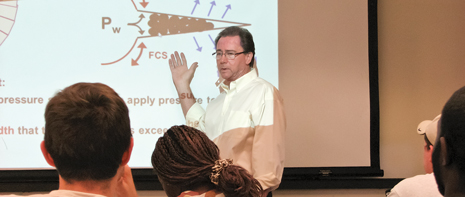Innovative thinkers
Fred Dupriest: Refusing to drill by the book
|
Hailing from a family involved in the downstream market, Mobil Chemical more specifically, Fred Dupriest started his career doing college co-op work in that very industry. But the same year that he finished his education, the world economy was shaken by an event that would have a profound effect on his choice of vocation: the energy crisis of 1973. “I could see at that time, after the embargo, how important the oil industry was to the entire world, and I wanted to be a part of that,” said Dupriest.
The final experience that pushed Dupriest solidly into the upstream sector was a recruiting trip that he attended at an Exxon rig site. “I stood there and looked at the tall pine trees and the plum groves, and I said, ‘I think I like this better.’” Feeling more at home out in the field than under a refinery roof, Dupriest has made his mark on the industry by implementing drilling procedures that place an emphasis on improving how drillers work, rather than just improving their technology. Much of the work that Dupriest did to enhance drilling, while at Exxon, came after investigating what were considered then to be tried-and-true drilling methods. In 2004, he applied an old formula for calculating bit power consumption, but did so in real time, to see how effective these procedures actually were, downhole. The more Dupriest and his team used this monitoring technique, the more problems they found with many so-called proven methods. “When we started looking at this in a very objective way for analyzing bit performance,” said Dupriest, “we found that many things didn’t work the way that we thought they did.” One practice that Dupriest exposed as problematic is what is known as “breaking in the bit.” This describes weight being applied to the bit very slowly, at each connection, which has long been considered conventional wisdom to many involved in the drilling process. “When we looked at the energy consumption of the bit, what we saw was that it was extremely high while there was light weight on bit,” said Dupriest. The high energy consumption indicated that a phenomenon called whirl was taking place: a violent, lateral, side-to-side shaking of the bit. Aside from causing inefficient boring, whirl also damages the outsider cutters, severely reducing bit life. Accordingly, Dupriest and his colleagues changed their drilling strategy to one of placing weight on the bit quickly. Both bit life and drill rate increased dramatically. Dupriest also explained that a focus on optimization, alone, is another practice that can hamstring and distract the drilling industry. Optimization consists of making smaller changes to fine-tune and improve performance, but according to Dupriest, optimization tends to stop, when a risk is encountered. For example, to solve the problem of borehole instability, personnel on the rig will increase the mud weight, which increases the pressure on the sides of the hole, preventing collapse. However, increasing the mud weight also increases the likelihood of pipe sticking. “So in 2004, we invented new practices that virtually eliminated all differential sticking,” said Dupriest, “Now when we ask people in operations to raise the mud weight, they’re not hesitant to do that at all.” Significant industry advances are, then, according to Dupriest, not so much the product of fastidious optimization, but rather the willingness to address those risks that stop drillers from using known solutions to their fullest. Although retired from the upstream business, Dupriest now teaches a senior-level advanced drilling course at Texas A&M University. The course focuses on not only drilling practices, but also on physics, to arm students with the necessary information to observe objectively what works and does not work, instead of merely sticking to established methodology. He received the 2013 SPE Drilling Engineering Award in March, for his contributions to the oil and gas industry. |
- Coiled tubing drilling’s role in the energy transition (March 2024)
- Using data to create new completion efficiencies (February 2024)
- Digital tool kit enhances real-time decision-making to improve drilling efficiency and performance (February 2024)
- E&P outside the U.S. maintains a disciplined pace (February 2024)
- Prices and governmental policies combine to stymie Canadian upstream growth (February 2024)
- U.S. operators reduce activity as crude prices plunge (February 2024)



